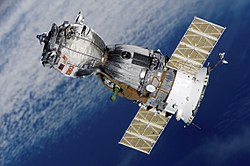| Operator | Roscosmos |
|---|---|
| COSPAR ID | 2008-015A |
| SATCAT no. | 32756 |
| Mission duration | 198d 16h 21m |
| Spacecraft properties | |
| Spacecraft type | Soyuz-TMA |
| Manufacturer | Energia |
| Crew | |
| Crew size | 3 |
| Members | Sergey Volkov Oleg Kononenko |
| Launching | Yi So-Yeon |
| Landing | Richard Garriott |
| Callsign | Eridan |
| Start of mission | |
| Launch date | April 8, 2008, 11:16:39 UTC |
| Rocket | Soyuz-FG |
| Launch site | Baikonur 1/5 |
| End of mission | |
| Landing date | October 24, 2008, 03:37 UTC [1] |
| Orbital parameters | |
| Reference system | Geocentric |
| Regime | Low Earth |
| Docking with ISS | |
| Docking port | Pirs nadir |
| Docking date | 10 April 2008 12:57 UTC |
| Undocking date | 24 October 2008 00:16 UTC |
| Time docked | 196d 11h 19m |
 From left to right: Yi So-yeon, Sergey Volkov, Oleg Kononenko Soyuz programme (Crewed missions) | |
Soyuz TMA-12 was a Soyuz mission to the International Space Station (ISS) which was launched by a Soyuz FG rocket at 11:16 UTC on 8 April 2008. It docked to the Pirs module of the station on 10 April 2008. [2] Landing occurred at 03:37 on 24 October. It was the first nominal landing in three missions, following separation failures on the Soyuz TMA-10 and 11 spacecraft.


